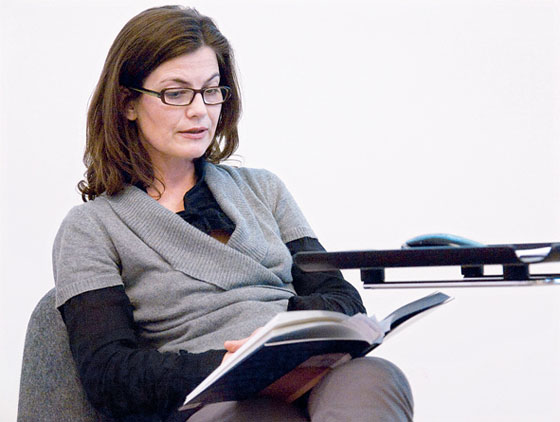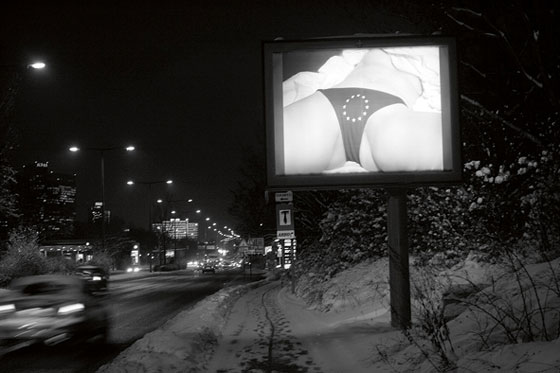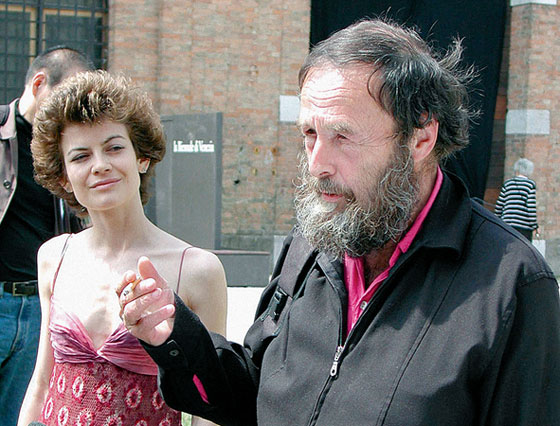|
|
| The body as a political instrument and platform for art in the works of Tanja Ostojić Laine Kristberga, Film and Art Historian | |
| Tanja Ostojić is a multi-disciplinary Serbian artist, born in 1972 in the former Republic of Yugoslavia. Her artistic career is more than a decade long, and she has undertaken a wide range of artistic work – from internet projects, performances and solo happenings to short films, video installations, posters, seminars, discussions and books. Currently Ostojić lives in Berlin, and in September 2010 she visited Riga in connection with the Riga contemporary art festival Survival Kit. Like female artists of previous generations from the Balkan region, of which possibly the most visible is the internationally renowned performance art pioneer Marina Abramović, Tanja Ostojić also uses her body both as a platform for art and a political instrument to express criticism about the processes in society and their influence on the individual, the convolutions of the power hierarchy and political ideology. Ostojić admits that the need to communicate with the public directly and without intermediaries naturally led to using performance as the chosen genre and the body as the medium in creating works of art. The artist emphasizes that at times she must sacrifice her private space and intimacy in order to generate confrontation and make the viewer think about certain existential, social or political questions. Frequently Ostojić uses radical means of artistic expression, including nudity, which are sometimes interpreted by the mass media and a large part of society as pornography. “Provocation is a speciality of mine,”(1) says Ostojić. | |
 Tanja Ostojić in Riga. 2010. Photo: Didzis Grodzs | |
| When in the 1990s Serbia was swept over by armed conflict, which was followed by a zealous restructuring according to the principles of Western democracy and socially-political system, a conflict between two monocultures became unavoidable: an ideologically despotic, xeno-phobic and patriarchal culture was placed in juxtaposition to liberal Western culture. Even today, the political climate of Serbia is ruled by this dual atmosphere: one part of society is frantically looking for a way to join the European Union, while another part looks at international society with huge suspicion. This leads to a topical question about the national identity and that of the individual – who am I as an individual, what values govern our society? Isn’t my identity getting crippled as a result of ideological pressure? Already in 2000 Ostojić started to research these kinds of issues by way of an interactive internet project Looking for a Husband with an EU Passport. To attract potential suitors, the artist uploads a nude photo of herself – an androgynous woman’s body, free of body hair, which serves as a mediator between private and public space. Ostojić deliberately creates an asexual and ascetic image, free of the traditional elements of sensuality and temptation, so that the body would not seem to be the body of Tanja Ostojić, but a universal anatomical construction and at the same time an ironic messenger. By using a semantically conflicting advertising slogan and photo, the artist reminds the viewer of the sad truth about the reality of such endeavours: the trafficking of women, prostitution, fictional and pragmatic marriages and other negative side effects. Thus Ostojić criticizes the objectification of a woman, when the woman is turned into a non-personal object and used as a commodity without an identity. However, you could also view the project in the wider context of the relationship between power and the individual. For example, Alison Butler, a researcher of feminism, says that “the body is at once the source of our first and most inalienable sense of self-possession, and, at the same time, an object over which the state has absolute power”.(2) A similar idea is expressed by Michael Foucault, who asserts that the body is directly related to politics and power relations have an immediate hold upon it: “Through positioning of power they invest it, mark it, train it, torture it, force it to carry out tasks, to perform ceremonies, to emit signs.”(3) The control of a ruling power over an individual is what Ostojić criticizes in her work Looking for a Husband with an EU Pass-port. By clearly demonstrating that marriage to an EU citizen is a strategic solution for escaping the “ghetto of Eastern Europe”, Ostojić turns against the elitism of EU political attitudes, and the absence of the human factor and understanding in the giant mechanism of bure-aucracy.As a clear example of control by the powers that be she mentions the EU Immigration police inspections of intermarriages between EU and non-EU citizens – even the warmth of the marriage bed can play a crucial role in issuing an EU residence permit.(4) The problems of migration and sex trafficking are also analyzed in the politically provocative work of 2004 After Courbet: L’origine du Monde, also called EU panties. This work shows the lower part of the artist’s torso clad in star-spangled EU-blue flag panties. The format of the work is a poster, and its main objective is to protest against the objectification of women in Western Europe and to speak out against imposing stereotypes and brands on them. Besides, it also reminds us of the numerous Eastern European women who have been forced or deceived into crossing the border illegally, to work in Western European brothels or in other miserable circumstances on minimum pay. The controversial popularity of the work was boosted immensely when, immediately after the work was displayed in Vienna and Graz, the mass media labelled it as unbecomingly pornographic. When the Vienna city authorities ordered the posters to be removed, the artist did not take offense, quite the opposite – she pointed out the fact that such censorship and display of might by the political executive is a threat to artistic freedom and the displaying of art in public places, especially when art was of a political nature or its authors women artists or artists from non-EU countries.(5) The work is still available for viewing in the digital media and the internet, which Ostojić considers to be the most accessible and largest public space. | |
 Billboard of Tanja Ostojić's 'Untitled (After Courbert: L'origine du monde)' in Vienna. 300x216 cm. 2005. Photo: Ursula Mayer. Courtesy: Tanja Ostojić | |
| Notwithstanding the immense and hypnotic size of the poster and the taboo theme, Ostojić’s aim is not to attract the viewer’s attention to the close-up of the genital organ, but rather to the emblematic circle of yellow stars – the EU symbol. In this way Ostojić demonstrates how ideology imposes its stamp on a human body; the work resonates with Abramović’s performance The Lips of Thomas, created in 1973, which was much more radical in its expression. In this performance Abramović tested the endurance of her body by cutting a five-pointed star on her bare stomach with a razor blade and sleeping on a cross-shaped ice block for several hours, thus utilizing both ideological and religious iconography to speak about her personal history and that of her nation. Ostojić doesn’t use such extreme means – she calls the viewers’ attention to power by dressing a socialist body in a new outfit. But the common semantic trend in both works is the branding of bodies with ideological symbols: the body of Abramović is branded with a communist star, which makes the body bleed, while Ostojić’s body is branded with exclusive EU panties, symbolizing the belief prevalent in post-socialist society about the prevailing comfort of capitalist systems. Jean Baudrillard states that “a woman broken down into a syntagma of erogenous zones is classified exclusively by the functionality of pleasure”.(6) Although nudity does not feature in this work by Ostojić, it is precisely this work with the close-up of an erogenous zone that has received the most criticism about pornographic content. The famous US performance artist Carolee Schneemann admits that she has had to bear similar reproaches – more so, her works have often become objects of ridicule: “Western, masculist art history has been obsessed with the female nude, but the image of a contemporary artist as a genitally sexed nude sets off a tireless round of inquisition: what is the meaning of this “obscene” image? Why is it in the art world rather than a “porno” world?”(7) In this context it should be remembered that Ostojić, Abramović, Schneemann and many other female artists use their bodies as a platform and depict themselves either as a work of art, or as part of one, to overturn the stereotypes governing patriarchal society. According to Schneemann, her body is visual territory, a supplemental tool which helps to convey information: “Covered in paint, grease, chalk, ropes, plastic, I establish myself as visual territory. Not only am I an image maker, but I explore the image values of flesh and material I choose to work with.”(8) In her work EU Panties, Ostojić achieves visual intensity by singling out and dismantling the reproductive organ of a woman; however, what she depicts is neither erotic nor pornographic. Such self-projection in a public space cannot be considered to be a narcissistic ego trip. Rather, it is a discussion about content and form, about the mutual interaction between the inner and the outer, the private and the public, where the boundary between the inner space of a body and the external world begins with the outer shell of the body. The body is presented in a similar way in the series Strategies of Success / Curator Series, 2001–2003, only this time Ostojić uses the body to express criticism of the hierarchy, the stereotypes and the institutionalization ruling the art world through the prism of gender studies and feminist theories. In the performance Be My Guest (2001), Ostojić rearranges the gallery Pallazo delle Esposizioni in Rome, by placing a bathtub full of water and foam in the middle of the room. Invitations sent out for the show announce that it is to be an informal gathering with drinks and snacks. However, when the guests arrive at the appointed time and place, a surprise awaits them – Ostojić is sitting in the tub naked together with the show’s curator Bartolomeo Pietromarchi. The guests have no choice but to watch both of them engaging in games of a sexual nature. This theatrical show is a fruit of fantasy, where different roles are played by Ostojić as an Eastern European artist, the performance curator from Western Europe and the spectators. The gallery and the curator are just props for the simulated sexual act, but Ostojić and the viewers have a chance to “blend” into one, becoming the Other through a shared experience. The performance reaches its culmination when art critic Ludovico Pratesi joins Ostojić and Pietromarchi in the hot tub, thus crossing the sacrosanct boundary between the artist and the critic. | |
 Tanja Ostojić. I'll be Your Angel. 2001. Photo: Borut Krajnc. Courtesy: Tanja Ostojić | |
| In her performance I’ll Be Your Angel (2001), Ostojić becomes escort and “guardian angel” to the Venice Biennale curator Harald Szeemann. Clad in a Christian Lacroix dress and high-heeled shoes, a radiant and charming Ostojić attends ceremonies, press conferences and parties together with Szeemann, thus demonstrating not only the power relationships in the art world, but also the marginal place allocated to women in the social hierarchy. Like a kind of fixed satellite and unconditional shadow, Ostojić follows the male curator, bearer of power and influence, with the aim of bypassing the corridors of power to reach the top of the art pyramid, a place that a woman artist from the Balkan region would rarely be lucky enough to attain. The researcher of Ostojić’s works Monika Mokre writes that in this project Ostojić did not only show the painful journeys a woman artist has to make in order to become acknowledged – she also showed the power the stalker has over the stalked, the observer over the observed.(9) Ostojić herself states that the work should mainly be viewed as an analysis of trust and power.(10) The by-product of the performance is a work which is inaccessible to viewers, Black Square on White (2001), done on her skin. Ostojić shaved a square into her pubic hair to emulate Malevich’s black square. During the biennale only Szeemann gets the opportunity to see this supreme composition, hidden “between Ostojić’s legs”. Thanks to the visible part of the artwork – the advertising campaign in the person of Ostojić – Black Square on White gains significant popularity and is included in the list of the artworks displayed at the biennale. Doctor of art Marina Gržinić thinks that the black pubic square has a likeness to Hitler’s moustache. According to her, Ostojić’s work indirectly points to principles of fascist ideology that are governing the institutionalized and commercialized art world.(11) Recalling the previously-mentioned work by Gustave Courbet, L’origine du Monde, and the scandal that this painting caused in the late 19th century, as well as the more recent hullabaloo about the reproduction of Venus displayed in the London underground transport system in 2008, one is forced to conclude that the depiction of female nudity in art, especially breasts and the lower part of the torso, can provoke somewhat conflicting reactions in society, disregarding the exploitation of the female body that richly decorates visual media these days. Female nudity has been used as a taboo theme also by feminist artists, for example, the Vienna actionist icon VALIE EXPORT in her canonical work Aktionshose: Genitalpanik (1969). In this performance she walked around the audience of a porno movie theatre with a gun in her hand, wearing crotchless pants revealing her pubic hair. Even though, in difference to Ostojić’s Black Square on White, she was displaying her pubic hair in public with the aim of making the perception of reality as true as possible, the ideas expressed in both works resonate with the 1970s feminist critique of the passive and sugar-coated image of the woman, which was especially propagated in Hollywood films. Both artists turn against the stereotypical depiction of a woman as the object of a man’s scopophilic lust, as an object pleasing to the eye, not as an equal person with her own views, feelings and emotions. Ostojić’s internet project Vacation with a Curator (2003) is her last work in the series Strategies of Success. The work consists of a number of photographs which parody paparazzi photos for celebrity gossip magazines. In these photos Ostojić is seen as a young artist at the zenith of her career, sunbathing with a male curator on the beach, who, similarly to Szeemann at the Venice biennale, symbolizes the institutional bearer of power. In this way Ostojić cynically points out that the key to a woman artist’s success is the seduction of a male curator. It is a characteristic of Ostojić to create long-term artworks – projects which intertwine various disciplines supplementing each other: the visual arts, performance, philosophy and politics. In the common cultural space, thematic analogies with the work of other women artists in various periods of time become unavoidable, but this only underscores the topicality and up-to-dateness of Ostojić’s art. It is important for Ostojić to cross the boundaries drawn by strict professionalism and the norms for the creation and display of art. In order to reach the largest possible target audience, Ostojić uses guerrilla and actionism strategies, mass media and public spaces as an alternative and non-commercial gallery space. And her own body is used by the artist as a uniting structural element and means of artistic expression, but mainly it is used as a powerful instrument of critique, embodying both content and form. (1) Tanja Ostojić’s web site: www.van.at/see/tanja (2) Butler, Alison. Women’s Cinema. London; New York: Wallflower, 2002, p. 95. (3) Foucault, Michael. Discipline and Punish: The Birth of the Prison. Penguin Books, 1991, p. 25. (4) During the project the artist received more than 500 letters from potential suitors in various European countries, the USA and Australia. After six months of correspondence Ostojić organized a public meeting with her future husband, a German artist Klemens Golf. On 9 January 2002 the couple was officially married in Belgrade and Ostojić applied for an EU residency permit. The project lasted till 2005, when there was a public divorce ceremony. During all this time Ostojić was not able to obtain an EU passport. (5) Tanja Ostojić’s web site: www.van.at/see/tanja (6) Baudrillard, Jean. The System of Objects. London: Verso, 2005, p. 110. (7) Elder, R. Bruce. Body of Vision: Representations of the Body in Recent Film and Poetry. Ontario: Wilfrid Laurier University Press, 1997, p. 244. (8) Ibid, p. 244. (9) www.van.at/howl/junction/kont02/kont42b.htm (10) Tanja Ostojić’s web site: www.van.at/see/tanja (11) www.springerin.at/dyn/heft_text.php?textid=970⟨=en /Translator into English: VIta Limanoviča/ | |
| go back | |







